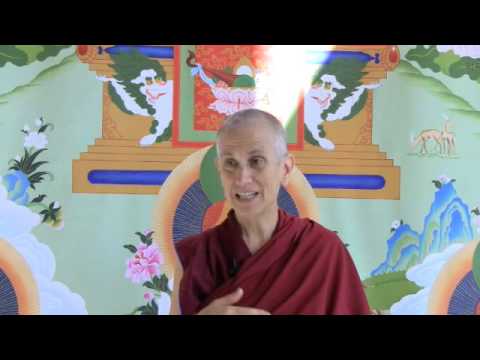Brain training: The effects of meditation on the brain

Spokane Dharma student Lesli Weber reports on fascinating research about the effects of meditation on the brain.
Ask almost any athlete, and they can tell you all about it, even if they haven’t experienced it themselves: the feeling described by some as euphoria, known as “the runner’s high”. When a person exercises at a sufficient intensity for a long enough period of time, they often begin to feel happy, even blissful, despite fatigue in their muscles or blisters on their feet. After medical science developed sufficiently advanced technology, researchers were able to confirm, and explain, the phenomenon of the runner’s high. It turns out that the mood elevation athletes report feeling comes from “a flood of endorphins in the brain” (Kolata, par. 8) in response to the physical stimulus of exercise. (Endorphins are your body’s natural version of opiates, making the owner of that endorphin-flooded brain feel very good, indeed.) So it is clear that physical training has a pronounced effect on the brain, which, in turn, influences one’s mental state. The intriguing question now is: does it work the other way around? Does mental training, more commonly known as meditation, affect the physical brain?
Modern science indicates that meditation does, in fact, have many effects on the physical brain. Not just any effects, either; meditation produces very beneficial changes in the human brain. Both short-term and long-term effects on brain function and structure have been observed by scientists, ranging from reduction in stress to slower age-related cerebral deterioration. Excitingly, science is just beginning to look at meditation’s effects on the brain, and we’ve already seen mountains of information on its benefits emerge.
What we have discovered begins with the short-term effects of meditation on brain function. Brain function is primarily measured in brain waves, the electrical changes brain cells (neurons) use to communicate with each other. Brain waves at different frequencies indicate different neural functions, as measured by an electroencephalogram (EEG). Additionally, the brain is divided into various parts and regions that are responsible for performing specific functions. Brain wave activity of certain frequencies in particular parts of the brain can tell a scientist a lot about what is happening within the brain, and what the result or perception of that activity will be to the brain’s owner. In a study conducted by neuroscientist Richard Davidson of the University of Wisconsin, Madison, the function of the brain during meditation was found to differ from the typical, non-meditative functioning in which we spend most of our waking hours. During meditation, “[a]ctivity in the left prefrontal cortex (the seat of positive emotions such as happiness) swamped activity in the right prefrontal cortex (site of negative emotions and anxiety)” (Begley, par. 12). In layman’s terms, the act of meditating made the study participants feel measurably happier. This increased cortical activity suggests that meditation “seems to help regulate emotions” (Cullen, par. 7), possibly by increasing the strength of the neural connections responsible for feelings of well-being through increased use of those connections, specifically, during meditation. Also, Davidson noticed a “dramatic increase in high-frequency brain activity called gamma waves” (Begley, par. 11). Gamma waves are known to be “involved in higher mental activity and consolidation of information” (Brain and Health), related to coordination and cohesion of higher-functioning mental activities, such as self-awareness, and comprehension and retention of information and ideas. Interestingly, both of these changes in activity were significantly greater in the brains of the Tibetan Buddhist monks involved in the study than they were in the brains of the novice meditators, suggesting that happiness, self-awareness, and concentration may, in fact, not be inherent, unchangeable predispositions, but may instead be skills that can be learned and improved with mental training.
In addition to increased gamma wave production, indicative of an increase in awareness and concentration, the brains of meditators have been shown to increase production of alpha, then theta, waves, while decreasing production of beta waves. According to Brain and Health, “alpha waves… occur when we are relaxed and calm”, “theta waves… are associated with sleep, deep relaxation…, and visualization”, while “beta waves… occur when we are actively thinking, problem-solving, etc.”. The results of a study published in Time magazine reported that even first-time meditators showed a decrease in production of beta waves, “a sign that the cortex is not processing information as actively as usual” (Park, par. 1), after just a single 20-minute session. After these same meditators had been training for an eight week period, their brain wave patterns during meditation shifted “from… alpha waves… to the theta waves that dominate the brain during periods of deep relaxation” (Park, par. 8), an indication that a state of deep relaxation was achieved with greater efficiency as experience with meditation increased. The Time study also noted changes in specific regions of the brain. During meditation, the frontal lobe “tends to go offline” (Park, par. 4). The frontal lobe is the area of the brain responsible for higher functions like “reasoning, problem solving, judgment, and impulse control” (Brain Health). This decrease in frontal lobe activity correlates to a simultaneous decrease in activity in the parietal lobe. The parietal lobe, which, along with the thalamus, processes sensory information about one’s environment, slows down to “a trickle” (Park, par. 6). This seems to indicate that during meditation, one’s brain ceases to try to absorb and interpret the outside world, instead turning one’s focus of attention inward, producing a deeply calm mental landscape.
Short-term effects on the brain during the actual process of meditating aren’t the only effects that scientists have noted, however. Several studies show that, much like regular weightlifting has an observable, long-term effect on the body’s muscles, regularly practiced mental training changes the actual physical structure of the brain. One such study, presented by research scientist Sara Lazar of Massachusetts General Hospital in Charlestown, reveals that certain areas of the brains of practiced meditators are actually thicker than those same cerebral areas in non-meditators. The “parts of the brain’s cerebral cortex responsible for decision making, attention, and memory” (Cullen, par. 3) were thicker in the study participants than in the average brain. Both “the prefrontal cortex, important in higher thought and planning, and the insula on the right side, a region that integrates emotions, thought and senses” (Phillips, par. 4) showed signs of increased thickness in the study’s meditators after the completion of the study. An exciting aspect of this observed thickening is the implications it has on the way we perceive age-related mental decline as inevitable, or at the least, expected. The very areas of the prefrontal cortex that showed increased thickening in the study’s meditators are areas of the brain that have been shown to be vulnerable to thinning, and corresponding decreased mental function, as we age. Whether the cause of the thickening is due to an increased number of neural connections, or greater blood flow to those areas during meditation, the “effect seems to reverse the usual cortical thinning” (Phillips, par. 4) that is often seen in the elderly. One of the more interesting facets of this particular study is the participants themselves. Meditation studies are often conducted on Buddhist monks, referred to as “the Olympic athletes of meditation” (Davidson qtd. in Cullen, par. 4). Lazar’s study participants were not Buddhist monks, but a selection of 20 average men and women from the Boston area who practiced meditation for 40 minutes a day for the duration of the study. The indication that the beneficial effects of meditation don’t require Olympic stamina or Buddhist vows to achieve holds global implications: they are potentially available to almost everyone.
That includes college students, according to a study conducted by Bruce O’Hara of the University of Kentucky. Randomly selected groups of college students were asked to “either meditate, sleep or watch TV” (Cullen, par. 5), then participate in a psychomotor vigilance test. Psychomotor vigilance refers to one’s ability to quickly and efficiently physically react to a perceived stimulus, in this case, to hit a button when study participants saw a light flash on a screen. The college students who had been instructed to meditate outperformed the sleepers. The meditators “performed 10% better” (Cullen, par. 5) than when they tested without meditating first—“a huge jump, statistically speaking” (O’Hara qtd. in Cullen, par. 5). Those students who slept before testing actually performed “significantly worse” (Cullen, par. 5) than on their prior test. (No mention is made of the test results of the TV watchers. Apparently, readers are meant to draw their own conclusions about the mental benefits of television viewing.) These results suggest that meditation may have a restorative effect on neural connections, much the same way sleep does, but without the accompanying grogginess.
In fact, a recent study conducted in China this year concluded that practitioners of a simple form of meditation showed not just improved attention, a factor in psychomotor vigilance, but also better autonomic self-regulation than a control group who practiced relaxation training, instead. (Relaxation training involves the progressive tensing, then relaxing, of the body’s various muscle groups.) Participants’ physiological data, as well as brain scans, were taken before, during, and after the five days of the study. The meditators “showed significantly better physiological reactions in heart rate, respiratory amplitude and rate, and skin conductance response… than the relaxation” (Tang, et al., par. 1) group did, both during and after the study. EEG scans showed increased theta activity in the ventral anterior cingulated cortex, the region of the brain responsible for some autonomic functions, such as heart rate variability (HRV). HRV refers to the heart’s slight increase in rate upon inhaling, and its slight decrease in rate upon exhaling, while one is resting. The healthier the autonomic nervous system (ANS), the more responsive the HRV will be in accordance with the breath. After the five days of the study ended, scans of the participants revealed that the meditation group “show[ed] better regulation of the ANS… than [did] the relaxation group” (Tang, et al., par. 1), due to the activity observed in the anterior cingulated cortex.
Another study, conducted by Richard Davidson (from earlier reference) and a group of colleagues, also found that a group of 25 meditators’ immune systems functioned more efficiently than did those of a non-meditating control group. For years, the medical community theorized that “the brain was shut away from the actions of the immune system” (“Direct Route from Brain…”). Now, medical science shows that the brain and the immune system are, indeed, linked. The immune system and the hypothalamus, the part of the brain responsible for production of the stress hormone, cortisol, appear to operate in conjunction. The more cortisol produced by the hypothalamus, the more suppressed the immune system becomes. When immune cells encounter large or constant amounts of cortisol in the bloodstream, they interpret that as the brain “essentially telling them to stop fighting” (Wein, par. 8). Stress itself can have a positive effect, if it serves to motivate, but excess or chronic stress appears to chemically deactivate the immune system, to an extent. The Davidson study taught a group of participants to meditate over an eight week period. Data collected at the conclusion of the eight weeks showed “increases in relative left-sided anterior activation that are associated with reductions in anxiety and negative effect and increases in positive affect” (Davidson, et al.) in the meditators brains. This is similar to what other studies have noted. The difference in this study is what occurred at this point. At the conclusion of the eight week meditation training, both groups were injected with a flu vaccine. At follow-up, there were “significant increases in antibod[ies]… among subjects in the meditation compared with those in the… control group” (Davidson, et al.). Interestingly, researchers noted that the “magnitude of increase in left-sided [brain] activation predicted the magnitude of antibody [response] to the vaccine” (Davidson, et al.). In other words, the happier and less anxious the meditators were directly correlated with how much more efficient their immune system response was. This may suggest that the effect of right-sided frontal brain activity, associated with anxiety and stress, is to stimulate the hypothalamus to produce greater amounts of cortisol, thereby suppressing the immune system. The practice of meditation shifts that brain activity from the right frontal lobe to the left, increasing feelings of a positive nature, such as happiness, which may, in turn, prompt the hypothalamus to produce less cortisol, thereby increasing the efficiency of the immune system.
It seems clear at this point that meditation does, in fact, produce many measurable, yet invaluable, benefits to the physical brain. As this brief sample of studies has demonstrated, just 20 to 40 minutes of training per day has been shown to increase feelings of well-being, decrease stress, maximize the functioning of various autonomic systems, and even slow, and possibly reverse, some age related mental deterioration, among other benefits. With all these benefits as the payoff for a comparatively small amount of effort, one could almost conclude that not meditating may even, in the long run, be a form of self-neglect. Arguably the best news of all: this is just the proverbial tip of the iceberg. Day by day, medical technology is advancing, giving us the ability to discover even more detailed information about the mysterious events that occur within our own brains. With all that has been uncovered thus far, science is sure to be investigating the effects of mental training on the brain for years to come. Given what we already know, considering we’re just starting, how much more might there be to discover?
Works Cited
Begley, Sharon. “Scans of Monks’ Brains Show Meditation Alters Structure, Functioning”. The Wall Street Journal: Science Journal. 5 November 2004. University of Wisconsin. 14 July 2009.
Brain and Health. Ed. Karen Shue. 2007. “The Basics of Brain Waves”. 24 July 2009.
Brain Health Puzzles. Copyright 2007 – 2009, “Facts on the Human Brain”. Wolfgang. Steven Looi. SBI. 28 July 2009.
Cullen, Lisa T. “How to Get Smarter, One Breath at a Time: Scientists find that meditation not only reduces stress but also reshapes the brain”. Time. 167.3 (16 January 2006): 93. Health Reference Center Academic. Gale. Spokane Community College Library, Spokane, WA. 12 July 2009.
Davidson, Richard J., Jon Kabat-Zinn, Jessica Schumacher, Melissa Rosenkranz, Daniel Muller, Saki F. Santorelli, Ferris Urbanowski, Anne Harrington, Katherine Bonus, and John F. Sheridan. “Alterations in Brain and Immune Function Produced by Mindfulness Meditation”. Psychosomatic Medicine: Journal of Biobehavioral Medicine. 27 December 2002. American Psychosomatic Society. 16 July 2009.
“Direct Route From Brain To Immune System Discovered By Scientists”. Medical News Today. 25 October 2007. 7 August 2009.
Kolata, Gina. “Yes, Running Can Make You High”. The New York Times. 27 March 2008. 5 August 2009.
Park, Alice.“Calming The Mind: Meditation is an ancient discipline, but scientists have only recently developed tools sophisticated enough to see what goes on in your brain when you do it”. Time 162.5 (August 4, 2003): 52. Health Reference Center Academic. Gale. Spokane Community College. 24 July 2009
Phillips, Helen. “How life shapes the brainscape: from meditation to diet, life experiences profoundly change the structure and connectivity of the brain”. New Scientist. 188.2527 (Nov 26, 2005): 12(2). Health Reference Center Academic. Gale. Spokane Community College. 24 July 2009.
Tang, Yi-Yuan, Yinghua Ma, Yaxin Fan, Hongbo Feng, Junhong Wang, Shigang Feng, Qilin Lu, Bing Hua, Yao Lin, Jian Li, Ye Zhang, Yan Wang, Li Zhou, and Ming Fan. “Central and autonomic nervous system interaction is altered by short-term meditation.(PSYCHOLOGY: NEUROSCIENCE)(Author abstract)(Report)”. Proceedings of the National Academy of Sciences of the United States. 106.22 (June 2, 2009): 8865(6). Health Reference Center Academic. Gale. Spokane Community College. 24 July 2009.
Wein, Harrison, Ph. D. “Stress and Disease: New Perspectives”. The NIH Word on Health. October 2000. 7 August 2009.


